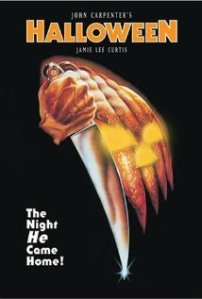John Carpenter’s masterfully directed king of slasher movies is a staple tradition of the holiday. Halloween is one of the earliest films of it’s kind and is at least partially responsible for the popularization of body count horror films that exploded in the 80’s. Carpenter uses a number of lighting and camera techniques to create low budget scares that don’t require impressive effects.
The opening scene is one of the most effective in horror history. It gives the first person point of view of a young Michael Myers as he creepily stalks around his house, moves up the stairway, and eventually slaughters his older sister. The use of first person in this situation is especially resourceful as it limits what the viewer can see, making the view suspenseful and scary. As Michael makes his way toward his sister, he picks up and puts on a clown mask, limiting his vision and the viewers vision even more. The most effective and surprising part of the scene is that, by using the first person POV, Carpenter does not have to reveal that the murderer is a small child until the very end of the scene. It comes as a shock when the POV is switched to third person and Michael is revealed to be a mere 8 year old boy.
The rest of the film takes place over a decade later, after Michael escapes from a mental institution as an adult. Myers is pursued by his psychiatrist, Dr. Loomis, played with a frantic concern by Donald Pleasance. For the first half hour or so Myers lurks behind bushes, keeping a low profile. He eventually acquires the infamous mask, making Myers stalking even creepier. This serves well for several suspense-building scenes, as Myers is spotted briefly and disappears quickly.
Laurie, the main victim of the film, is played with innocent and virginal qualities, by Jamie Lee Curtis. This may be where the virgin-surviving-horror movies stereotype started. All of the other main teenagers constantly talk about and indulge in sex, and are often killed soon after intercourse. Carpenter claim in interviews that it was not his intention to punish the sexually active and reward the virgin, but it certainly seems that way. Especially considering Myers has little other motive. He simply snaps as a child and remains insane. He doesn’t really have any reason to kill people, aside from his mental illness, though his motives for stalking Laurie are explained in later films.
Capenter lights the film with high contrast, allowing for the victims to be lit, while leaving plenty of dark spots for Myers to hide and pop out of. He also allows for shadows to creep up over the unsuspecting victims, so the viewer can see Myers silhouette before they see Michael himself. Through these techniques, Carpenter proves that horror can be scary without costly effects while also giving credit to the idea that what is left unseen is often scarier than what is visible.
Halloween is an innovative and impressive horror flick, but it is often given a bit too much credit for jumpstarting the slasher genre. Psycho, Texas Chainsaw Massacre, and Black Christmas all came before this movie and each contributed just as much as Halloween did to the genre. However, Carpenters skilled direction and smart scare techniques do allow Halloween to surpass it’s predecessors in quality, with the exception of Psycho maybe.
A-

[…] Halloween (1978) (reanimation101.wordpress.com) […]